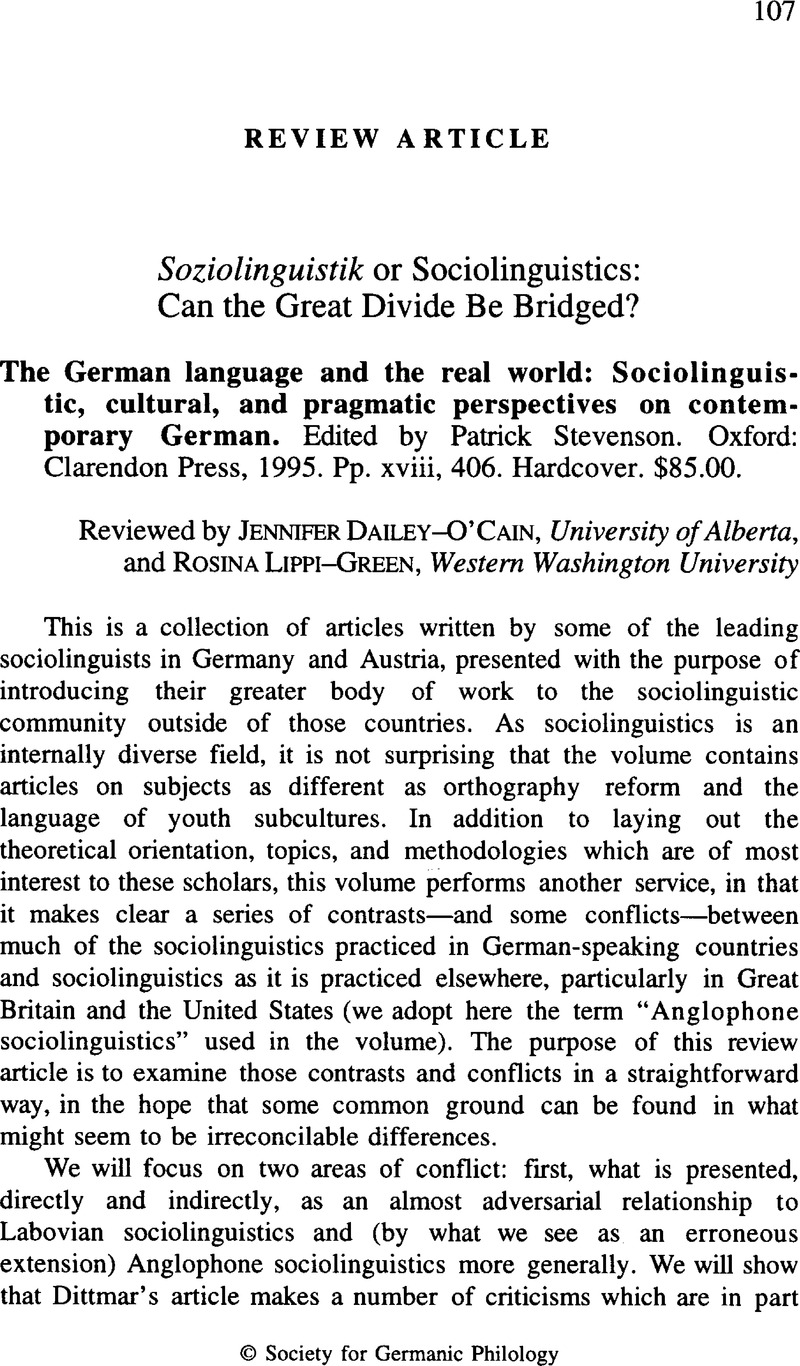No CrossRef data available.
Article contents
Soziolinguistik or sociolinguistics: Can the Great Divide Be Bridged?
Published online by Cambridge University Press: 05 December 2008
Abstract
An abstract is not available for this content so a preview has been provided. Please use the Get access link above for information on how to access this content.

- Type
- Review Article
- Information
- Copyright
- Copyright © Society for Germanic Linguistics 1998
References
REFERENCES
Ammon, Ulrich. 1991. Die Internationale Stellung der deutschen Sprache. Berlin: Walter de Gruyter.CrossRefGoogle Scholar
Barbour, Stephen, and Stevenson, Patrick. 1990. Variation in German: A critical approach to German sociolinguistics. Cambridge: Cambridge University Press.Google Scholar
Bell, Allan. 1984. Language style as audience design. Language in Society, 13.145–204.CrossRefGoogle Scholar
Bereiter, Carl, and Engelmann, Siegfried. 1966. An academically oriented pre-school for culturally deprived children. Pre-school education today, ed. by Hechinger, Fred M., 105–37. Garden City, NY: Doubleday.Google Scholar
Bernstein, Basil. 1974. Class, codes, and control: Theoretical studies towards a sociology of language. 2nd edn.London: Routledge.Google Scholar
Chambers, J. K. 1995. Sociolinguistic theory: Linguistic variation and its social significance. Oxford and Cambridge, MA: Blackwell.Google Scholar
Dailey-O'Cain, Jennifer. 1997. Geographic and socio-political influences on language ideology and attitudes toward language variation in post-unification Germany. Doctoral dissertation, University of Michigan.Google Scholar
Dailey-O'Cain, Jennifer. Forthcoming. The perception of post-unification German regional speech. Handbook of perceptual dialectology, ed. by Preston, Dennis. London: Sage.CrossRefGoogle Scholar
Dittmar, Norbert. 1973. Soziolinguistik: Exemplarische und kritische Darstellung ihrer Theorie, Empirie und Anwendung. Frankfurt a. M.: Athenäum-Fischer.Google Scholar
Eckert, Penelope. 1989. The whole woman: Sex and gender differences in variation. Language Variation and Change 1.245–67.CrossRefGoogle Scholar
Eckert, Penelope. 1990. Cooperative competition in adolescent “girl talk.” Discourse Processes 13.91–122.CrossRefGoogle Scholar
Fennell, Barbara A. 1992. Markers of ethnic identity in immigrant worker German. The Language Quarterly 30.1–19.Google Scholar
Gass, Susan M., and Varonis, Evangeline M.. 1994. Input, interaction, and second language production. Studies in Second Language Acquisition 16.283–302.CrossRefGoogle Scholar
Horowitz, Frances Degen, and Sullivan, Joseph W.. 1981. Mother-child interaction issues: Summary chapter. Early language: Acquisition and intervention, ed. by Schiefelbusch, Richard L. and Bricker, Diane D., 251–56. Baltimore: University Park Press.Google Scholar
Humboldt, Wilhelm von. 1904. Gesammelte Schriften. Vol. 4. Ed. by Leitzmann, Albert. Berlin: B. Behr.Google Scholar
Hundt, Markus. 1992. Einstellungen gegenüber dialektal gefärbter Standard-sprache: Eine empirische Untersuchung zum Bairischen, Hamburgischen, Pfälzischen und Schwäbischen. Stuttgart: Franz Steiner Verlag Wiesbaden.Google Scholar
Kelman, Herbert C. 1971. Language as an aid and barrier to involvement in the national system. Can language be planned?: Sociolinguistic theory and practice for developing nations, ed. by Rubin, Joan and Jernudd, Björn H., 21–51. Honolulu: University of Hawaii Press.Google Scholar
Labov, William. 1972. The logic of nonstandard English. Language in the inner city. Philadelphia: University of Pennsylvania Press.Google Scholar
Labov, William. 1990. The intersection of sex and social class in the course of linguistic change. Language Variation and Change 2.205–54.CrossRefGoogle Scholar
Lippi–Green, Rosina. 1997. English with an accent: Language and discrimination in the United States. London: Routledge.Google Scholar
Mickartz, Heinrich. 1983. Einstellungsäußerungen zur Verwendung von Hochsprache und Mundart in der Kindererziehung. Sprachverhalten in ländlichen Gemeinden: Dialekt und Standardsprache im Sprecherurteil, ed. by Hufschmidt, Jochen et al. , 60–116. (Forschungsbericht, Erp-Projekt, 2.) Berlin: Schmidt.Google Scholar
Milroy, James. 1992. Linguistic variation and change: On the historical sociolinguistics of English. Oxford and Cambridge, MA: Blackwell.Google Scholar
Milroy, James, and Milroy, Lesley. 1991. Authority in language: Investigating language prescription and standardisation. 2nd edn.London and New York: Routledge.Google Scholar
Milroy, James, and Milroy, Lesley. 1993. Mechanisms of change in urban dialects: The role of class, social network and gender. International Journal of Applied Linguistics 3.57–77.CrossRefGoogle Scholar
Silverstein, Michael. 1992. The uses and utility of ideology: Some reflections. Journal of Pragmatics 2.311–24.Google Scholar
Woolard, Kathryn A., and Schieffelin, Bambi B.. 1994. Language ideology. Annual Review of Anthropology 23.55–82.CrossRefGoogle Scholar




